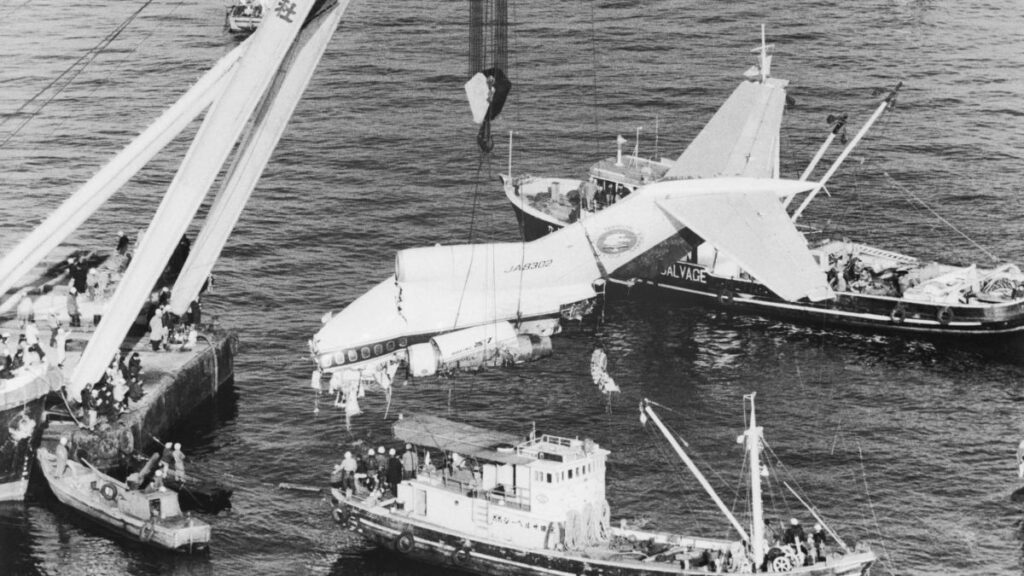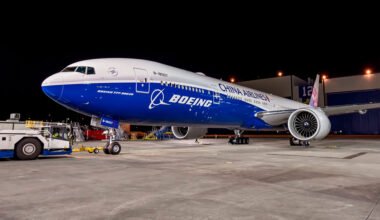Boeing 727 – the first trijet airliner
Boeing 727 is the first-ever rear narrow-body trijet airliner by Boeing Commercial Airplanes. The aircraft was built to carry on the successful legacy of its predecessor, Boeing 707. B727 has the cockpit and fuselage design as same as 707. However, the first Boeing 727 entered service on February 1, 1964, with Eastern Airlines. B727 has an engine on both sides of the fuselage adjacent to the leading edge of the tail fin.
The third rear engine is mounted in the tail cone of the fuselage and connected to an air intake on the top of the fuselage at the leading edge of the tail fin by an S-duct. Boeing decided to produce the 727 by keeping in mind the immense demand of airlines. The airlines demanded an aircraft to operate at smaller airports. Boeing decided to produce a trijet by an agreement between 3 major airlines (United Airlines, Eastern Airlines, and American Airlines).
United Airlines wants four engines to operate at their Denver hub which is at a high altitude. However, American Airline was looking for a two-engine aircraft for more efficiency. On the other hand, Eastern Airlines wants more than two engines due to their overwater routes to the Caribbean. Then, the agreement has been done on trijet and the development process began. At first, Boeing collaborated with de Havilland to complete the project. But later, this collaboration could not go any further and Boeing alone start the development of the aircraft.

Risky start of Boeing 727
In the early stages, Boeing 727 enjoyed great fame in the aviation industry around the globe. In fact, Boeing has decided to build only 50 727s but ended up producing a total of 1,832 aircraft. The trijet airliner had a great demand among airlines operating at smaller as it has the ability to land on shorter runways. Boeing produced this aircraft for more than 21 years and finally ceased production in September 1984. The aircraft which was once considered ‘very risky to travel on’ became one of the highest-selling airliners. It was the first aircraft to cross over the 1,000 sales mark. Although, the aircraft took a very risky start but ended up getting o lot of fame.
After entering the service in 1964, the aircraft gets into some fatal crashes in less than 3 months, hence, terrifying people a lot. The aircraft was considered to be fatal to travel on. Many agents avoided people booking flights on 727 and even some major corporations asked their employees to avoid Boeing 727 flights. All these accidents created a great controversy around the globe, even some demanding to ground the aircraft. These accidents include:
- On August 16, 1965, United Airlines flight 389 crashed into Lake Michigan while descending for landing at O’Hare Airport. It killed all 30 people on board.
- On November 8, 1965, American Airlines flight 383 crashed during its approach to Greater Cincinnati, killing 62 out 0f 66 people on board (3 passengers and one crew member survived)
- November 11. 1965, United Airlines flight 227 crashed on landing at Salt Lake City International Airport, killing 43 out of 91 onboard.

FAA’s decision to not ground the aircraft
The CAB (Civil Aeronautics Board) and FAA (Federal Aviation Agency) jumped into the controversy and started doing investigations. The CAB reviewed 727’s airworthiness and aerodynamics. The reviews showed the aircraft to be airworthy and safe to fly. However, some further investigations cleared that there is no problem with the aircraft but with the pilots not understanding the flap system. The 727 has an advanced wing design including an advanced triple-slotted flap system, allowing lower landing speeds as well as high cruising speeds.
In the light of these results, FAA denied all the demands to ground the aircraft. Furthermore, FAA asked airlines to train their pilots to comply with the procedures and flight manuals of newly produced aircraft. Although this decision saved the career of the aircraft, however, it took some time for the aircraft to gain back its trust in the public.
After serving, the industry for many years, the aircraft went towards its end journey. The aircraft was replaced with a more advanced Boeing 757, produced in the 1980s. As for the aircraft in service, most of them retired in the early 2000s as the airlines get bored of their noisy engine. Only some freighters are left in the service. The first produced Boeing 727 was flown to the Museum of Flight in Seattle and put on display in March 2016.
Boeing 727 Specs
| Boeing 727 Specs | 727-100 | 727-200 | 727-200 Advanced | |
| Engines (3x) | Pratt & Whitney JT8D-1 | Pratt & Whitney JT8D-9 | Pratt & Whitney JT8D-17R | |
| Thrust (3x) | 62-64 kN (14,000-14,500 Ibf) | 62-67 kN (14,000-15,000 Ibf) | 64-77 kN (14,500-17,400 Ibf) | |
| Seating Capacity | 131 | 189 | 189 | |
| Range | 4,170 km | 3,500 km | 4,720 km | |
| Length | 40.6 m | 46.7 m | 46.7 m | |
| Flight Crew | 3 crew members: (pilot, co-pilot, flight engineer) | 3 crew members | 3 crew members | |
| MTOW (Maximum take-off weight) | 76,700 kg | 78,100 kg | 95,100 kg | |
| Height | 10.4 m | 10.65 m | 10.65 m | |
| Max. Fuel Capacity | 29,069 L | 30,620 L | 40.060 L | |
| Wingspan | 32.92 m | 32.92 m | 32,92 m | |
| Wing area | 153 sq m | 153 sq m | 153 sq m | |
| Service Ceiling | 11,000 m | 13,000 m | 13,000 m | |
| Max. Cruising speed | Mach 0.9 | Mach 0.9 | Mach 0.9 | |
| Typical Cruising Speed | Mach 0.84 | Mach 0.84 | Mach 0.84 | |
| Take-off | 2,500 m | 2,600 m | 3,100 m |
Featured Image: Lee Adcock




